calsfoundation@cals.org
Slovak (Prairie County)
Slovak (originally called Slovactown or Slovaktown), an agricultural community founded in 1894, still endures and is home to the Church of Saints Cyril and Methodius, who are also known as the Apostles of the Slavs. Slovak is the result of the promotional efforts aimed at encouraging immigrant settlement in Arkansas in the 1890s.
Various Slovak fraternal and nationalistic organizations, such as the National Slovak Society, translated advertisements promoting the favorable agricultural areas of Arkansas into the Slovak language at presses in Pennsylvania, Ohio, and Illinois. Following such advertisements, the Slovak Colonization Company was organized in 1894 in Pittsburgh by Peter V. Rovnianek. The company bought 3,000 acres of Arkansas land for settlement in the southern portion of Prairie County. This site was planned for an agricultural community on untouched grassland and included 160 acres in the center of the tract for a township and lots for farms, the church, and a school.
In the fall of 1894, twenty-five families arrived at the Slovactown site. Farmers and coal miners who had struggled in the northeastern United States headed many of these families. This first group of immigrants arrived at DeValls Bluff (Prairie County) by rail and then proceeded to their new homes by wagon. The newly arrived settlers erected a community house where the pastor of Stuttgart (Arkansas County), twelve miles south of Slovactown, provided religious services. By 1895, letters to the Bishop Edward Fitzgerald requested a Roman Catholic priest devoted solely to Slovactown. The growing Slovak congregation, under the guidance of another Stuttgart priest, built its first church in 1900.
By 1909, about fifty families had settled in Slovactown. Most of these families were Slovak, but a few were Bohemian and Russian. This community built another church, the Church of Saints Cyril and Methodius, around 1914, and yet the congregation still did not have a parish priest. In the absence of a priest, men of the Miklik, Matoske, Konecny, and Dolny families conducted services. By 1910, the Slovaks stopped cutting prairie hay and began farming rice as the region experienced the economic boom associated with the introduction of rice. By 1916, rice was the mainstay crop of the community.
The congregation of Saints Cyril and Methodius finally received its first resident pastor when Father Louis Glinski arrived in 1917. Dr. G. H. Keller replaced Father Glinski as the parish priest in 1923. Keller organized the youth of the community into the Slovac Catholic Club, blessed a new community house in 1924, and was also responsible for the installation of a water system and electric light plant in Slovactown. Slovactown was a parish of sixty farm families in 1925.
Several farmers in the Slovak area were forced to sell their land to make room for the 4,000-acre Peckerwood Lake, which Edgar Monsanto Queeny, a St. Louis, Missouri, industrialist, created by adding a levee to LaGrue Bayou in 1942. By 1948, the population was made up of about ninety families. In the early 1950s, an estimated 500 citizens of Slovak descent lived on farms in or around Slovak. During this time, businesses also came to include crop dusting, seeding, and private flying businesses. During the 1950s, Father Frank Janesko acted as clergy for the community; Janesko was raised in Slovak and came from a family of the original settlers to the area. The Slovak community continues to be largely defined by farming, kinship, and religion. The Church of Saints Cyril and Methodius is currently attended through Stuttgart and continues to serve as the religious, social, and cultural locus for the community. The Knights of Columbus Oyster Supper is held at Slovak during the first part of the year. In 2015, the community inaugurated Slovak Heritage Day, an annual celebration of Slovak culture.
For additional information:
Earl, Jack. “Little Slovakia in Arkansas.” Arkansas Democrat Sunday Magazine. January 27, 1952, pp. 1–2.
Freeman, Felton D. “Immigration to Arkansas.” Arkansas Historical Quarterly 7 (Autumn 1948): 210–220.
Franko, George. “Slovak Colonists in Arkansas.” Grand Prairie Historical Bulletin 62 (October 2019): 21–24.
Historical Commission of the Diocese of Little Rock. The History of Catholicity in Arkansas, from the Earliest Missionaries Down to the Present Time. Little Rock: The Guardian, 1925.
Hodges, Leroy. “Slavs on Southern Farms: An Account of the Bohemian, Slovak, and Polish Agricultural Settlements in the Southern States.” Washington DC: Government Printing Office, 1914. Online at https://curiosity.lib.harvard.edu/immigration-to-the-united-states-1789-1930/catalog/39-990052877920203941 (accessed November 9, 2021).
Kaza, Greg. “Letter from Arkansas: Oyster Supper.” Chronicles, March 2006, pp. 38–39.
Kochurov, John. “Report on a Visit to Slovaktown in 1899.” Grand Prairie Historical Bulletin 62 (October 2019): 30–31.
Morris, Sarah. “This Church Is Named for Patron Saints of Slovakia.” Arkansas Catholic, March 10, 2023. Online at https://www.arkansas-catholic.org/news/article/7748/This-church-is-named-for-patron-saints-of-Slovakia (accessed March 13, 2023).
Woods, James W. Mission and Memory: A History of the Catholic Church in Arkansas. Little Rock: August House, 1993.
Jamie Metrailer
University of Arkansas at Little Rock
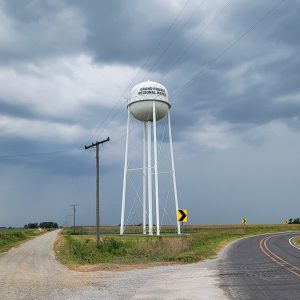 Grand Prairie Water Tower
Grand Prairie Water Tower 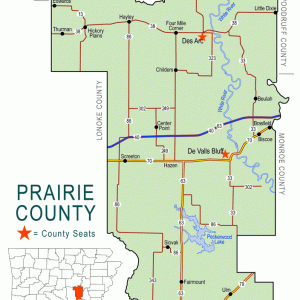 Prairie County Map
Prairie County Map  Russian Orthodox Church in Slovak
Russian Orthodox Church in Slovak 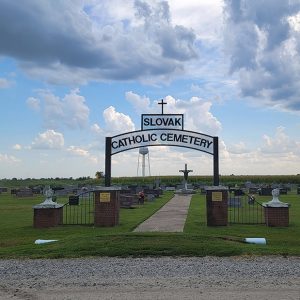 Slovak Catholic Cemetery
Slovak Catholic Cemetery 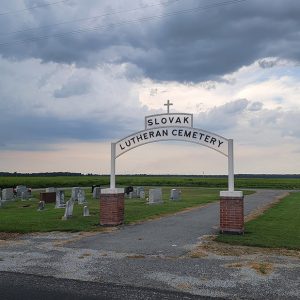 Slovak Lutheran Cemetery
Slovak Lutheran Cemetery 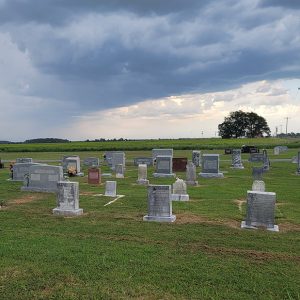 Slovak Lutheran Cemetery
Slovak Lutheran Cemetery 



Andrew Schustek, my grandfather, was involved in the settlement of Slovak Town. He is credited to have “directed the founding of a farming settlement in Arkansas, known as ‘Slovak Town,'” in two publications on the history of Slovaks in America. This is among his many other accomplishments, particularly as a major participant in the development, signing, and international acceptance of the Pittsburg Agreement of 1918.